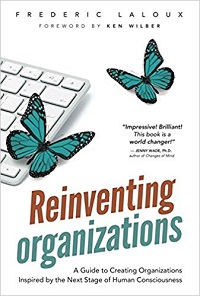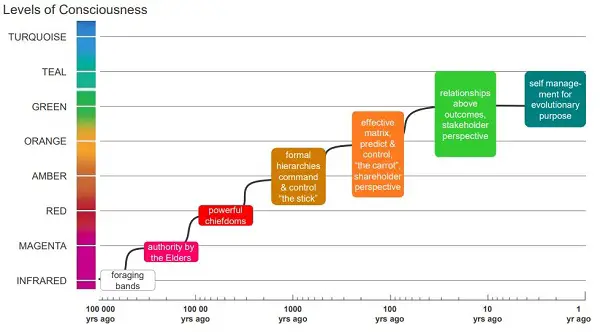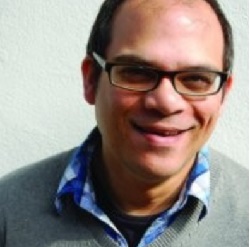|
TRANSLATE THIS ARTICLE
Integral World: Exploring Theories of Everything
An independent forum for a critical discussion of the integral philosophy of Ken Wilber
  Frank Visser, graduated as a psychologist of culture and religion, founded IntegralWorld in 1997. He worked as production manager for various publishing houses and as service manager for various internet companies and lives in Amsterdam. Books: Ken Wilber: Thought as Passion (SUNY, 2003), and The Corona Conspiracy: Combatting Disinformation about the Coronavirus (Kindle, 2020). Frank Visser, graduated as a psychologist of culture and religion, founded IntegralWorld in 1997. He worked as production manager for various publishing houses and as service manager for various internet companies and lives in Amsterdam. Books: Ken Wilber: Thought as Passion (SUNY, 2003), and The Corona Conspiracy: Combatting Disinformation about the Coronavirus (Kindle, 2020). Frederic Laloux
| ||||||||||||
| THE CENTAURIC SELF | |
|---|---|
| cognitive style | transverbal vision-image, high-phantasy, synthesis of primary and secondary process; trans-consensual |
| affective elements | prehension, spontaneity, impulse expression, supersensory, heart-felt |
| conative/motivational factors | intentionality, creative wish, meaning, spontaneous will, self-actualization, autonomy |
| temporal mode | grounded in the present moment, aware of linear time as exfoliating from the present |
| mode of self | integrated, autonomous, trans-biosocial, total body-mind being |
Many of these characteristics will return in Laloux's descriptions of the new type of organization and its members: autonomy, wholeness and vision. One can question Wilber's accurateness in interpreting the psychological and philosophical literature or dismiss them as outdated, but this is the research behind the notion of "Teal".
To complicate things: there's an overlap with the preceding color Green here. In most of his works, Wilber therefore speaks of "early" and "late centaur", to make this finer distinction. Some critics have noticed that most of the companies Laloux describes are more properly characterized by Green qualities instead of Teal qualities. This severely undermines his point that we need to move on to a "next stage".
In a book written at the same time, Wilber applied these insights to the cultural history of humanity: Up from Eden (1981)[6]. It is here that the source for Laloux's notion of different and subsequent phases of human organization can be found. Wilber takes the reader on a journey through "archaic", "magical", "mythical", and "mental-egoic" time periods, in which each of these phases had its own worldviews, forms or religion, morality, and general outlook on life. He explains that he does hold on to a strictly developmental view of individual consciousness, but takes the notion of socio-cultural stages of humanity more lightly:
"I have chosen to tell the story of mankind's "painful growth" in terms of several major "eras". I have done this mostly as a matter of convenience, and do not hold to the "rigid era" school of history (although I do hold to a structural/developmental view of individual consciousness, and thus the "eras" I will present are based on the average structure of consciousness dominant at that period." (p. x).
Again, one can question Wilber's accurateness in interpreting the anthropologial and psycho-historical literature or dismiss them as outdated, but this is the research behind the notion of psycho-historical stages. (Granted, this material was written 35 years ago by Wilber and published by non-academic trade publishers, and the absence of a lively academic discussion in the intervening period about his views is not very promising).
In fact, this approach has been heavily criticized by at least one anthropologist, Michael Winkelman. In a review of Up from Eden written in 1982 he claimed Wilber had grossly underestimated the cognitive capacities of the pre-modern stages.[7] What is more: even chimpanzees turn out to have more advanced cognitive capacities than Wilber was willing to grant to primitive man. Here too, Winkelman's final verdict was harsh: "Wilber's theory is found to be lacking because of the structure of his arguments, the accuracy or competency of his selected authorities, and the relevant evidence he fails to consider."
Incidentally, this is typical of Wilber's approach to scientific disciplines: he has such a strong drive to tell a certain story about reality, that he can be selective in his choice of sources when amassing evidence to support this story. What is more, the sources he neglects to include are often exactly the specialists in the relevant fields (this is not only true in the case of anthropology, but also in the case of evolutionary theory, as we will see in the second part of this essay). True science prevents this from happening by a public debate among specialists within a certain field, where all involved are willing to update their points of view when confronted with conflicting evidence. In Wilber's case, this has rarely if ever happened. Though he claims he has revised his own views several times when he encountered new data, this is still not the same as a public debate, where potential blind spots can more easily be exposed.
So in sum, postulating that there is "no scientific basis for the arguments made in this book. No, not even a little", when it comes to psycho-historical stages of humanity, seems like overstating the case. At the same time, a thorough scientific debate about these unorthodox points of view hasn't happened in decades, and knowing Wilber will probably not happen any time soon. An uncritical adoption of Wilber's writings (not to mention an uncritical application to matters of society) seems in any case not a very promising route to take. In defense of Wilber, he has at least attempted to formulate a view of individual and socio-cultural development that includes as many scientific and philosophical sources as possible—though critics might beg to differ as to how inclusive he has really been.
The Problem of Context
The second concern Hassan raises is about the contextual nature of human behaviour:
"Behaviours are context-dependent, and not necessarily dependent on a state of consciousness rooted in biological realities (even as they may be a function of biological realities—for example unconscious epigenetic reactions).... A constant use of an evolutionary frame also provides the contentious impression that our “organizational” behaviours (how the Catholic Church is organized for example) are somehow linked to our biology. I mean, they might be, but once again the point is to say “how,” rather than simply make the claim as if this were an obvious, uncontested truth.
Perhaps the use of the term "evolutionary" by Laloux (and Wilber) wrong-foots Hassan here. What they have in mind is that human behaviour is as much the result of mentality as it is of biology. The choice to join the mafia or Ben & Jerry's is contextual, according to Hassan, and not rooted in our biology, but why could it not be a matter of affinity we feel with their respective value patterns? In every country around the world the difference in value patters between city dwellers and rural inhabitants is striking. Same brains, different values. Shouldn't that tell us we are overlooking a major area of data when confining ourselves to the human brain alone?
A second source of ambiguity is that the Teal (or Integral or Second Tier) stage of development is often defined as providing the capacity to reach down the previous lower stages and use them when appropriate. Contrary to the Green stage, where power, order and process are shunned in favor of human well being, in the Teal stage these strategies are kept for situations where they seem appropriate. One wonders why this "integrative" nature of this future stage shows up only now: are not all stages meant to have integrated what went before during healthy development? And is Laloux faithful to this view of human development in that he let's the Teal stage play this flexible role or does he picture it really as a future stage that fundamentally transcends all the previous ones?
A third complication is that according to these models we don't all live in the same world. Rather, each stage of development sees its own world (or rather "life world"). This point is strongly emphasized in Spiral Dynamics and Integral Theory alike. A Blue stage person sees and values an ordered society with strong norms, a Green stage person sees a world of harmony and peaceful relations, and a Teal stage person might see reality as evolutionary and purposeful. So the message is not that "we all have to become Teal" but that we need to let everybody be at the stage he is in (until he or she wants to move on). So what's Laloux's message: is Teal the answer for everybody or only for a handful of evolved human beings ready to take the "next step"?
This view leads easily to a kind of superiority, where the higher stage person can "understand" those at a lower stage, but not vice versa, where arrogance is just around the corner
The veracity of this claim cannot of course be tested—but it conveniently allows for someone at the “highest” stage of consciousness to “understand” a lower level but not the other way around. (Or far worse, that anyone objecting to the theory is simply told they are operating from a lower level of consciousness, which is why they don’t get it.)
Unfortunately this has been exactly the stance of Ken Wilber towards his many online critics over the past decades. This can be summarized by the phrase "you just don't get it"—hardly an attitude that facilitates the critical exchange of ideas and the revision of one's own positions when needed.[8]
Hassan concludes:
If Laloux is seeing “Teal” as some sort of meta-context for our times, then what can we actually say about it? The only thing we could legitimately say is that our times are getting more complex. Situations of high complexity are situations of great fluidity, the opposite of stable situations. And in situations of high-complexity we cannot cut-and-paste prescriptions across contexts. Laloux's stance towards context is essentialist, that is, he treats it as a stable and non-complex thing that just is. There is no sense of how context changes or the processes by which different contexts come into being. Prescriptions offered without any contextual guidance is a glaring example of this essentialist stance.
In Spiral Dynamics this insight is firmly established: complex times require a complex answers and a certain flexibility on our part ("flexflow" is the shorthand they use). Every change in the "life-conditions" triggers a new mentality or mental structure (or "value meme"), such that living in a desert would require other capacities than living in New York city. In that sense the contextual nature of behaviour is well understood. But that doesn't prevent us from speculating if at the same time our interior nature is not at play as well.
The Problem of Ethnocentrism
Given the fact that only 5% of Western society (and organizations) is ready for the Teal revolution (according to estimates provided by Laloux) Hassan raises the issue of ethnocentricity. Is this all a kind of Western invention that gets imposed on other cultures without any reservation? Does Laloux hide this fact by presenting the story as "evolutionary" suggesting that this is all a matter of scientific fact?
Hassan is very doubtful of the idea that after millions of years of evolutionary stasis, all of a sudden 5% of Western society can and will undergo a miraculous transformation to a state of harmony with nature.
While biologists would agree that all of us have a Paleolithic mind, the argument being made is that some of us (5% in the West to be exact) have somehow, in the last 100,000 years evolved a whole different mind.
But the point of Laloux (and Wilber) is that this long process has been gradual and step-wise, in identifiable stages illustrated by the colors. Even if that is still a debatable point of view regarding human evolution, it does make a possible "next step" more likely.
The boundaries between what constitutes individual behaviour, individual consciousness, worldviews, organizational culture, and a historical milieu all blend seamlessly into a chain of proximate causes—one directly causes the other. This intellectual sloppiness here is staggering. The linkages and relationships between these very different things represent, in many ways, the holy grail of understanding the human condition. Yet Laloux writes as if these relationships are well understood and uncontested. (Which, of course they are for some New Age philosophers.)
Ken Wilber claims to have exactly (at least the contours of) such a "theory of everything", that includes the insights of the multitude of social and physical sciences regarding human consciousness. One can question his grandiose claims, but not without having examined the arguments he has put forth in their favor.
For one, if his model can be called "ethnocentric", his ethnocentrism is decidedly Eastern, not Western. On top of the stages discussed and presented by Laloux Wilber has room for several stages of individual spiritual development (mostly based on Buddhist traditions) which will sound unfamiliar for Western ears when heard for the first time.[9] The quasi-universality of the integral model might sound a lot like the "catholicity" of Roman Catholicism in that it is a religion "meant for all", but at least the intention behind it is presenting a universal view of human possibilities.[10]
THE CRITIQUE OF PATRICK VERMEREN
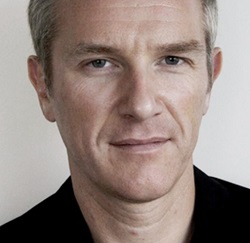
Patrick Vermeren
Patrick Vermeren, a Belgian consultant and co-founder of the Evidence Based HRM website, shows even less patience with Laloux's (and Wilber's) theories about human psychology and history, and especially when these are applied to his own field of expertise: evidence-based human resource management. In this field literally hundreds of hypes and fads come and go, and Vermeren has taken up the task to expose what he sees as pseudo-scientific fallacies.
Reviewing Reinventing Organizations (in Dutch) he makes the more serious point that Laloux's methodology is questionable. Laloux claims to have done "research" for two years by studying 12 innovative companies and presenting their case studies, but does that justify his thesis that these companies represent a new phase in human organization? Starting with a theory and then selecting examples to support the theory is not exactly a scientifically valid approach. Indeed, the evidence Laloux presents is highly anecdotal. Says Wikipedia: "Anecdotal evidence is often unscientific or pseudoscientific because various forms of cognitive bias may affect the collection or presentation of evidence." One can compare this to the question: how did Maslow select people who were self-actualized? Though it is certainly part of the scientific process, it is in itself not enough.
Laloux seems to concede as much in a note towards the end of the book (quoted in part by Vermeren):
Of course, we should be careful about the possibility of a selection bias. While I have researched all the organizations I have found that correspond to the research criteria (more than 100 employees, operating for at least five years on the principles and practices inspired to some significant degree by the Evolutionary-Teal paradigm) it could well be that only particularly successful organizations caught my attention." (p. 345, n1)
To which Vermeren adds the cynical comment: "Yes, indeed, Frederic, and therefore you shouldn't have written the book. Or at least have admitted what your sources are and have avoided the impression of being scientific. By pretending this body of knowledge is scientific, he clearly puts himself in the company of pseudo-scientists."
Regarding the frequent use of colors, both by Spiral Dynamics, Integral Theory and Laloux, to denote stages of individual or cultural development, Vermeren remarks: "the colors were chosen in a completely arbitrary way by Chris Cowan in less than 15 minutes, so don't look for any deeper meaning." I think there is more to this. The original descriptive terms used by Clare Graves for his stages were rather cumbersome, such as "G-T" or "F-S". Mainstream developmental psychology uses terms such as "pre-operational thought" or "post-formal thought". As a shorthand for these abstract notions, Cowan came up with associative color names, following the general rules of color psychology—so calling them "completely arbitrary" seems like overstating your case. This needn't have taken a lot of time. That does not contradict the fact that the stages these colors refer to go back to hundred years of psychological thought and research and might very well have a real existence.
Vermeren further criticizes Laloux's use of the notion of self-actualization, or even the Maslovian needs-hierarchy as such, for example in the following quote from Laloux's book:
“Evolutionary teal: The next stage in human evolution corresponds to Maslow's 'selfactualizing' level; it has been variously labeled authentic, integral, or Teal. This stage is the last one identified by Maslow's hierarchy of needs (though he later hinted at another stage of 'self-transcendence'), but other researchers and thinkers have established with a fair amount of confidence that evolution doesn't stop there.” (blz. 43)
Vermeren comments. "The concept of self-actualization (self-realization) is a very vague one that is no longer accepted by modern psychologists and has been repudiated by Maslow himself." [source?] Googling the issue I found a comment that is relevant for our discussion[11]:
In reviews of research based on Maslow's theory, little evidence has been found for the ranking of needs that Maslow described, or even for the existence of a definite hierarchy at all.
“Here's the problem with Maslow’s hierarchy,” explains Rutledge[12]. “None of these needs—starting with basic survival on up—are possible without social connection and collaboration…. Without collaboration, there is no survival. It was not possible to defeat a Woolley Mammoth, build a secure structure, or care for children while hunting without a team effort. It’s more true now than then. Our reliance on each other grows as societies became more complex, interconnected, and specialized. Connection is a prerequisite for survival, physically and emotionally.”
“Needs are not hierarchical. Life is messier than that. Needs are, like most other things in nature, an interactive, dynamic system, but they are anchored in our ability to make social connections. Maslow's model needs rewiring so it matches our brains. Belongingness is the driving force of human behavior, not a third tier activity. The system of human needs from bottom to top, shelter, safety, sex, leadership, community, competence and trust, are dependent on our ability to connect with others. Belonging to a community provides the sense of security and agency that makes our brains happy and helps keep us safe.”
In some ways, life hasn't changed our fundamental human natures. Whether it's the ancient Savannah or today's Facebook and Twitter, social behaviors adapt to the environment to support that most basic of human needs. Social connection is ever-present.
A lot of our discussion is touched on here. Both our ancient heritage and our different current needs are mentioned. We don't need to play them out against eachother. Some people need stability and order, some need adventure and challenge, some need overview and control. A "one size fits all" prescription seems unworkable. Even an outdated model such as Maslow's can be "rewired" to fit contemporary scientific insights into human behavior. In the same spirit, Spiral Dynamics doesn't treat the colors as stages or types of people, but, as the saying goes, "types in people". But in that case, a stage-interpretation of human history becomes less and less feasible. In my opinion, since the various colors are said to emerge chronologically, both in individual and cultural development, a stage model is definitely what is meant here.
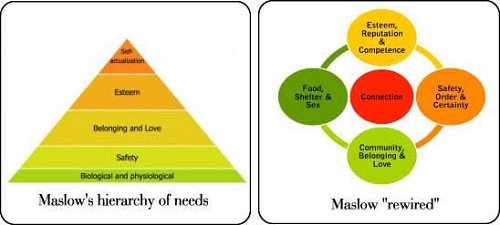
Vermeren also suggests that the complex, counter-intuitive and ad hoc nature of these models raises doubts against their validity. Wouldn't more simple theories be possible and even preferable? In his opinion, "these theories definitely exist, think only about the explanatory framework of evolutionary biology, evolutionary psychology, and the modularity of our brain and the modern theories of needs and motives. [examples?] More complex theories need more solid evidence. Contrary to evolutionary theory, we don't have any solid evidence."
Furthermore, like Hassan he points to the fact that there is no convergence with accepted models of evolutionary psychology, when it comes to the socio-cultural stages of humanity, with these colorful alternatives. Vermeren makes the valid point that Graves' 1970 article (about the "Levels of Existence") is the only article that can be found in the database of the American Psychological Association about this body of knowledge, with no references by other researchers. So nobody has taken up the task of testing or validating these ideas. "The ideas by neither Graves nor Wilber have been picked up by serious biologists or psychologists." A different database used in the social sciences, the ProQuest database, does yield hits about the work of Graves, but mostly by authors who are already convinced of the value of Spiral Dynamics. This is, in itself, I agree, a serious structural credibility problem.
A final pont of contention brought forward by Vermeren in a review of a Spiral Dynamics related approach practised in Belgium (Management Drives), is, however, related to the worldview (or "ideology" if you will) behind all these models.[13] Ken Wilber has been a strong critic of neo-Darwinism and is for all practical purposes a creationist—or rather an “mystical evolutionist”. I have challenged many of Wilber's statements on evolution on many occasions on this website[14], and agree with Vermeren on this point. It is highly ironic that an author who understands so little of evolutionary theory uses the term "evolutionary" at every turn. This does not immediately disqualify his writings on management and socio-cultural matters, but makes him at least suspect in more secular and skeptic circles. It also explains the semi-religious nature of current "Teal movements" that are preparing themselves for the "next step", "big jump", "great shift" or "momentous leap" which supposedly lies ahead of us all. Many readers of Laloux will be sensitive to this spiritual dimension.
I would suggest we take all these unorthodox management models on a case-by-case basis and evaluate them against all the available evidence—while refraining from absolute and categorical statements, on both sides of the fence.
NOTES
[1] Frederic Laloux, Reinventing Organizations: A Guide to Creating Organizations Inspired by the Next Stage of Human Consciousness,
[2] Zaid Hassan, "Is Teal The New Black? Probably Not", social-labs.org, July 13th, 2015. Reposted on Integral World: May 2018.
[3] Patrick Vermeren, "Recensie: de onzin in ‘Reinventing Organizations’ van Frederic Laloux", evidencebasedhrm.be, January 25th, 2016.
[4] Don Beck & Chris Cowan, Spiral Dynamics: Mastering Values, Leadership and Change, Blackwell, 1996.
[5] Ken Wilber, The Atman Project: A Transpersonal View of Human Development, Quest Books, 1980.
[6] Ken Wilber, Up from Eden: A Transpersonal View of Human Evolution, Anchor Press/Doubleday, 1981.
[7] Michael Winkelman, The Evolution of Consciousness, An Essay Review of Up from Eden (Wilber, 1981), 1982. Published in: Anthropology of Consciousness, 1(3-4), 1990. Reposted on Integral World, August 2016.
[8] Frank Visser, "The Wild West Wilber Report: Looking back on the Wyatt Earp Episode", www.integralworld.net, July 2006.
[9] Frank Visser, "Climbing the Stairway to Heaven, Ken Wilber's Mystical Religion of the Future", www.integralworld.net, June 2017.
[10] Corporate Rebels, "Bursting the Bubble: Teal Ain't Real", corporate-rebels.com, December 20, 2017. These Dutch bloggers are sympathetic, though not uncritical, towards Laloux and his work. They voice their concern about the fact that most companies Laloux describes in his book (and which they personally visited), do not live up to the Teal standards and that the model will lead to misplaced feelings of superiority when used as a spiritual ladder. When confronted with Wilber's spiritual stages their comment is funny but telling: "The supermind, the meta-mind? Right. We suspect Ken might have spend too much time in the famous coffee shops here in Amsterdam." In their blogpost "Experiencing wholeness with Frederic Laloux", March 13, 2016, based on a visit to Laloux's home, they conclude: "Every theory reflects [the values of] its creator". This probably goes for critics as well.
[11] Steve Denning, "What Maslow Missed", forbes.com, March 29th, 2012.
[12] Pamela B. Rutledge, "Social Networks: What Maslow Misses: None of Maslow’s needs can be met without social connection", Psychology Today, November 8th, 2011.
[13] Patrick Vermeren, "Spiral Dynamics en Management Drives", evidencebasedhrm.be, November 17th 2013.
[14] Frank Visser, "The 'Spirit of Evolution' Reconsidered: Relating Ken Wilber's view of spiritual evolution to the current evolution debates", www.integralworld.net, August 2010.
